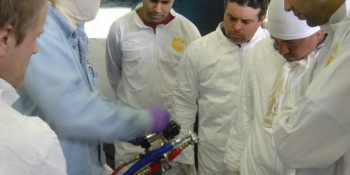Q&A Forums
Icynene install problems --- remedy? Post New Topic | Post Reply
| Author | Comments |
|---|---|
|
Melody Bowdon
Posted: Oct 12, 2008 06:57 PM
|
Icynene install problems --- remedy?
Within the last week I had Icynene installed by an authorized Icynene installer in my new addition. Today I noticed that the foam has pulled away from the studs in many places. I'll call the installer tomorrow, but I want to be fully informed when I speak with him. For example, should I insist that the entire room be stripped & reinsulated? Is there anything else that can be done? The ceiling is a cathedral ceiling, with the foam applied directly to the underside of the roof deck, so I'm worried that the Icynene has pulled away from that also. What do you suggest? I'm beginning to dread my expensive foam decision... Thanks. Melody in NC P.S. I wish that I had paid more attention when they were installing it --- I don't know if they did anything that was suggested in your article "Testing for Quality Foam Insulation During Field Application", but I do know they said they were having "gun issues"! |
|
mason
Posted: Oct 13, 2008 08:04 AM
|
Immediately contact Icynene about the problem. They have an online warranty program that explains their responsibility and procedures to take if there is a problem. Let your contractor know your concerns and ask for a written response of their intentions in regards to your situation. |
|
Melody Bowdon
Posted: Oct 13, 2008 02:43 PM
|
Thanks for the fast reply. We called the installer & they admitted to a "bad batch" that day. They will call back within a day or 2 to schedule another installation. Question: Is it OK if a thin layer (1-2 mm) of the "bad batch" is left on the studs or shall we insist that all residue is removed so that the foam can adhere properly? Thanks again. Melody in NC P.S. I contacted Icynene, but have yet to hear back from them. |
|
mason
Posted: Oct 14, 2008 08:10 AM
|
This is very subjective. If it can be determined that most of the foam is on ratio and on spec and the bad foam can easily be identified and removed, then the rest of the foam can stay. However, if it is unclear which foam is good or bad, it should be removed. Go to Icynene's website, there will be a section for consumers where you can obtain your warranty and report your problem |
|
Edward Brassington
Posted: Oct 15, 2008 12:26 AM
|
The problems you are experiencing sound quite normal for Icynene. I was an Icynene dealer. I dropped it because of the adhesion issues, it seems that about five years ago Icynene changed the formula to gain more yield. In Canada they could not get the product certified for almost four years. That was quite a nightmare with building inspectors. The problems with poor adhesion are common with Icynene. Also check for voids in the foam, you will probably find large pockets in the foam. By simply tapping on the foam you can tell by the pitch where the voids are. Icynene always claims the problems to be "installer error". I have even had Icynene's chief technical advisor spray with my truck, after he had set it up the way it was supposed to be. He could not get the foam to stick to the substrate or to itself with multiple passes. In reality Icynene does not perform much better than fiberglass, the R value is the same, the adhesion is poor and voids are common. Good luck. |
|
Posted: Oct 15, 2008 10:24 PM
|
A "bad batch that day". Nice! Wonder how many other jobs got sprayed with that same "bad batch" and are already covered up. I don't know what a "bad batch" is, but if my foam were junk it wouldn't be in the wall. It would be on the truck back to the supplier. It seems to be common to blame the foam for what is typically installer error. Tim |
|
mason
Posted: Oct 16, 2008 08:01 AM
|
When a foam job goes bad (ie, shrinkage, poor adhesion, lousy cell structure, bad compressive strength, strong odor, etc), many factors can cause it. Out of the 18-20 factors that can negatively affect the application, 4 can be attributed to the supplier/distributor and the other 14to 16 to the contractor. So, how do you protect yourself as a contractor against that occasional "bad batch" of foam. (and yes it does happen). 1. Store your materials within the temperature and humidity required by the supplier and document it. 2. Keep lot numbers of all materials, the date it was manufactured, 3. Keep a daily log of the jobsite conditions including, temperature, dewpoint temperatures, substrate type and moisture content, and temperature 4. Keep a daily log of your equipment including pressure and temperature settings, type of gun, mixing chamber, spray pattern any anomalies that occured during the application. 5. Keep track of how much was sprayed, where and when. Calculate your yield and compare it to the supplier's data sheet. (note: foam yields vary considerably with temperature and skill of the applicator. Learn to determine the yield based on your applicator's skill and the climate.) 6. Develop an inspection report for your own use. Include details such as adhesion, thickness of foam and lifts, relative compressive strength of foam, and the information from your daily job logs. The more information you have the greater the help you should receive from your supplier if a problem develops. Remember, 95% of problems are contractor related, so your supplier has to be convinced that you have done all you can to install the foam correctly. You might ask how a supplier's foam can become a "bad batch" 4 things come to mind 1. The material was shipped or stored in too high or too low a temperature. 2. The material was old 3. The material was not blended right at the manufacturer. 4. Contamination in the drums/containers or the hoses filling the drums |





























